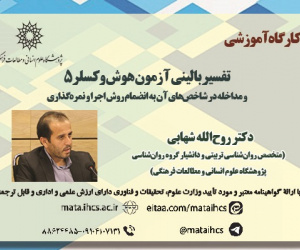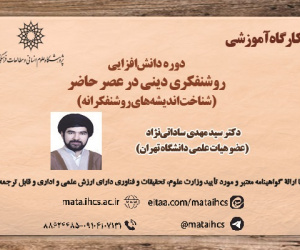طراحی الگوی پیش بینی و ارزیابی همکاری راهبردی نظام بانکی و استارتاپ های فینتک با رویکرد استنتاج فازی عصبی- تطبیقی (مقاله علمی وزارت علوم)
درجه علمی: نشریه علمی (وزارت علوم)
آرشیو
چکیده
اهداف: این پژوهش با هدف ارائه الگوی پیش بینی و ارزیابی همکاری راهبردی نظام بانکی ایران با استارتاپ های حوزه فینتک انجام شده است.روش: از ابزار مصاحبه و روش داده بنیاد برای بهره گیری از نظرات خبرگان استفاده شده است که شامل 14 نفر از خبرگان نظام بانکی و شرکت های حوزه فینتک بوده اند. 31 شاخص در قالب شش عامل مؤثر بر همکاری راهبردی نظام بانکی و استارتاپ های فینتک شناسایی و برمبنای آن، الگوی مفهومی پژوهش طراحی شد. سپس با استفاده از رویکرد فازی و نرم افزار متلب، همکاری راهبردی نظام بانکی با استارتاپ های فینتک با استفاده از نظرات 320 نفر از مدیران و متخصصان فعال در صنعت بانکداری و استارتاپ های حوزه فینتک ارزیابی شدیافته ها: نتایج نشان می دهد که مهم ترین ابعاد مؤثر بر همکاری راهبردی نظام بانکی با استارتاپ های فینتک به ترتیبِ اهمیت عبارتنداز: موانع و مشکلات ورود به همکاری های راهبردی، ابعاد و مؤلفه های برون سازمانی، عوامل تبیین کننده همکاری بانک ها و فینتک ها، انواع سطوح همکاری بانک ها و فینتک ها، پیامدهای ورود به همکاری های راهبردی، انگیزه بانک ها و فینتک ها در ورود به همکاری. سطح همکاری راهبردی نظام بانکی و استارتاپ های فینتک در محدوده متوسط رو به بالا قرار دارد. باتوجه به میزان خطای به دست آمده و نبود پدیده فرا انطباق در انفیس طراحی شده، الگوی مذکور اعتبار پذیرفتنی و قدرت بالایی برای پیش بینی دارد.نوآوری: این پژوهش نه تنها با آشکارسازی ابعاد مهم همکاری، بلکه با ارائه یک الگوی پیش بینی معتبر یاری می رساند. این پژوهش به دلیلِ رویکرد جامع خود، ترکیب دیدگاه های متخصصان، شاخص های گوناگون، و ابزارهای تحلیلی پیشرفته، بینش های ارزشمندی را برای تقویت همکاری راهبردی میان نظام بانکی و استارتاپ های فینتک ارائه می دهد.Designing a Forecasting Model and Evaluating the Strategic Cooperation between the Banking System and Fintech Startups using the Adaptive Neural Fuzzy Inference System (ANFIS)
This research aims to develop a robust predictive model for evaluating the strategic cooperation between Iran's banking system and fintech startups. Leveraging insights from 14 experts within the banking and fintech sectors, a hybrid methodology involving the foundation's interview tool and data analysis was employed. Thirty-one indicators, categorized into six key factors influencing strategic cooperation, were identified. Using a fuzzy approach and MATLAB software, a conceptual model was crafted to assess the strategic cooperation of the banking system with fintech startups. Input from 320 industry professionals and managers further enriched the analysis. The findings underscore the pivotal dimensions shaping this cooperation, including barriers to entry, external factors, explanatory elements, varying cooperation levels, consequences of collaboration, and the motivations driving banks and fintechs. The level of strategic cooperation was determined to be in the medium to high range. Notably, the Anfis-designed model exhibited acceptable validity and predictive power. This study contributes not only by unraveling critical cooperation dimensions but also by furnishing a reliable predictive tool. The comprehensive approach, amalgamating expert insights, diverse indicators, and advanced analytical tools offers valuable insights to fortify strategic cooperation in the banking-fintech nexus.Keywords: Startup, Fintech, Strategic Cooperation, Banking System, Fuzzy Inference System. IntroductionThe rapid evolution of financial technology (fintech) has instigated a profound transformation in the global banking sector, challenging established norms and prompting the need for strategic collaboration (Li et al., 2023). In response, this study delves into the strategic cooperation between traditional banks and fintech startups, recognizing that these entities must leverage each other's strengths, share resources, and attain common objectives (Jia et al., 2023).Collaboration between banks and fintech startups unlocks numerous benefits, enhancing growth and innovation within the financial ecosystem. Banks with regulatory knowledge and expansive customer bases provide fintech access to networks and financial resources. Concurrently, fintechs, with technical expertise and disruptive ideas, propel technological advancements and accelerate processes (Hu et al., 2019). Despite the extensive exploration of fintech's impact, a research gap persists in understanding the dimensions influencing strategic cooperation between banks and fintech startups (Yang & Wang, 2022).In the context of Iran's burgeoning fintech sector, the dynamics of strategic cooperation with traditional banks remain largely unexplored. This study addresses this gap by crafting a comprehensive model through a literature review, in-depth interviews, and content analysis. The primary research question guiding this inquiry is: What dimensions and key components influence strategic cooperation between Iran's banking system and fintech startups?This research is pivotal, uncovering untapped potential in Iranian collaboration and providing a framework for policymakers and industry stakeholders. It facilitates efficient collaboration, fosters innovation, improves financial services, and benefits customers and the Iranian banking industry. Materials and MethodsEmploying a grounded theory approach, this study formulates, rather than tests, theories through inductive reasoning. Initially, a semi-structured questionnaire was designed, informed by the literature, and administered to 14 experts with a minimum of a master's degree, and over a decade of experience in digital banking, startup management, and fintech. Utilizing snowball sampling, interviews achieved theoretical saturation by the twelfth, with two additional interviews for verification. ATLAS.ti software facilitated data analysis, extracting dimensions used to formulate and test a model via a questionnaire. Face and content validities, along with Cronbach's alpha, ensured questionnaire reliability.Calculating a sample size of 291 with Sample Power v3.0.1, 321 questionnaires were distributed, receiving 320 responses from experienced banking and fintech professionals. Respondents, purposively selected, rated strategic cooperation on a scale of 0 to 10. Neuro-adaptive fuzzy inference system (ANFIS) was employed for inference rule design using MATLAB.ANFIS, a blend of fuzzy inference and neural networks, was chosen for its capacity for nonlinear problem-solving. The model's accuracy surpasses regression, aligning with reality for precise forecasting (Azar & Faraji, 2017). ANFIS building involves clustering the output variable and fuzzy expansion in input spaces, forming a rule base. This approach ensures flexibility in adjusting weights, presenting a superior alternative to multivariate regressions.The study adheres to a systematic process, from data collection to ANFIS modeling, to scrutinize the adaptive neural fuzzy system intricacies (Azar & Faraji, 2017). FindingsThe study unfolds an innovative framework, leveraging an Adaptive Neural Fuzzy Inference System (ANFIS), to scrutinize strategic collaboration dynamics between Iran's banking realm and burgeoning fintech enterprises. In this endeavor, six pivotal dimensions, embracing collaboration incentives, influential factors, diverse cooperation levels, external organizational elements, hurdles, and resultant outcomes, constitute the ANFIS inputs. The resulting mathematical model incorporates a principal ANFIS and six sub-ANFIS modules, each scrutinizing the ramifications of a specific dimension, illustrated in Table 1. Table 1: Research Dimensions and ComponentsComponentsSymbolDimensionsMain componentMarket development needs (MD), Financial aspects (FA),Innovation motivations (IM), Emerging business ecosystem (BE)SCMStrategic Cooperation Motivations Strategic cooperation between the banking system and fin-tech startups (SCOBF)Digital transformation (DT), Technology infrastructures (TI), Structural factors (SF), Organizational factors (OF), Cultural factors (CF), Manager tact (MT),Trust making (TM), Legal features (LF)EFOCEffective Factors on CooperationConventional cooperation (CC), Strategic cooperation (SC),Dynamic cooperation (DC)LCBFLevels of Cooperation Between Banks and FintechPeripheral factors (PF). International factors (IF), Law making (LM),Policy making (PM), Government and parliament (GP), Banking syndication (BS)EOFExternal Organizational FactorsTechnology limitations (TL), Economic barriers (EB), Procedure barriers (PB), Security challenges (SC), Legal barriers (LB)SCBStrategic Cooperation BarriersBusiness development (BD), Value making (VM), Efficiency improvement (EI), Transparency improvement (TM), Risk indicators (RI)SCOStrategic Cooperation Outcomes Moreover, the ANFIS design integrates Gaussian functions, ensuring differentiability and adaptability to diverse data patterns. The initial membership functions, depicted in Figure 1, set the stage for subsequent modeling by illustrating the shape and characteristics of linguistic variables in the ANFIS system. These initial functions provide the groundwork for the ANFIS to effectively capture the intricacies and relationships inherent in the strategic cooperation between the banking system and fintech startups. Figure 1: Initial membership function for evaluating the strategic cooperation of the banking system and fintech startups The study proceeds to the ANFIS training and error analysis phase, employing both backpropagation and hybrid methods. The average error of 7.7 * 10-8 showcases the high validity and accuracy of the model. The subsequent implementation of the mathematical model, as detailed in Table 2, illustrates the input and output values for the main model, offering a comprehensive overview of the strategic cooperation evaluation. Table 2: ANFIS Input and Output Values for Strategic CooperationSCOBFSCOSCBEOFLCBFEFOCSCMInput variables7.606.176.96.686.176.66Output values Furthermore, the model undergoes meticulous validation through dataset testing and limit condition testing, ensuring its applicability, accuracy, and reliability. Additionally, sensitivity analysis and impact rate ranking of research dimensions underscore the pivotal role of overcoming barriers, as encapsulated by the dimension "SCB", in shaping and fostering effective strategic cooperation. Discussion and ConclusionsThe research concludes with a comprehensive exploration of strategic cooperation between Iran's banking sector and fintech startups, illuminating key dimensions that significantly influence collaboration. The study introduces a robust model comprising 31 indicators across six factors, elucidating the intricacies of strategic cooperation. Emphasizing the transformative potential of collaboration, the analysis pinpoints crucial dimensions, including barriers, organizational factors, effective cooperation factors, and motivational aspects. The model, evaluating strategic cooperation at a commendable score of 7.06, underlines the prospect for innovation and positive transformation in financial services.Recommendations for policymakers, industry stakeholders, and regulators are delineated, focusing on fostering a culture of cooperation, facilitating strategic partnerships, embracing digital transformation, ensuring regulatory support, prioritizing talent acquisition, and developing customer-centric solutions. These proposals aim to cultivate an environment conducive to effective collaboration, innovation, and sustainable growth in the Iranian banking industry.The study identifies limitations, cautioning against generalizing findings to other regions and industries. Acknowledging biases associated with self-reported data, suggests future research adopt mixed-method approaches. Encouraging longitudinal studies and exploration of additional dimensions, such as technological advancements and cultural factors, is advised. The call for knowledge exchange between researchers, practitioners, and policymakers emerges as a key theme, underscoring the importance of collaboration to deepen industry insights.In essence, while providing valuable insights, the research acknowledges its limitations and proposes a roadmap for future investigations. By addressing these limitations and embracing the outlined recommendations, the field can advance, expanding knowledge and adapting to the evolving dynamics of the banking and fintech sectors.







